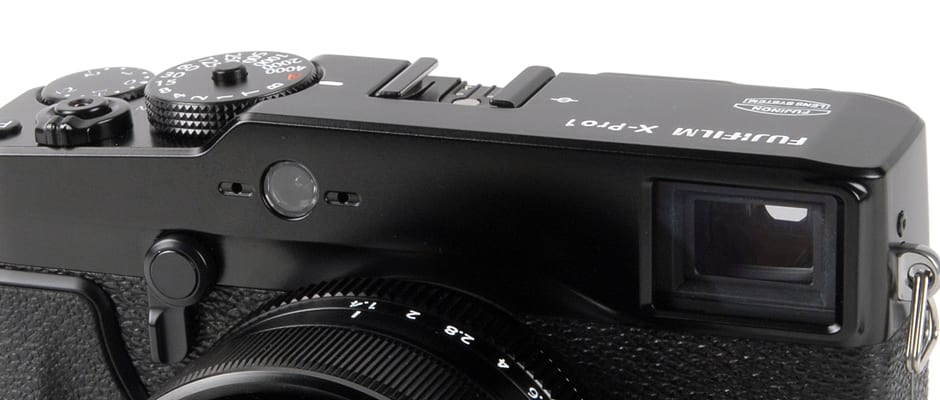Pros
Cons
Video Review
Introduction

2012 Best Enthusiast Camera
The brand new X-Pro1 is Fujifilm's flagship digital camera, the ultimate device for old-school hobbyists who crave the style and mechanical control of classic cams. Do not be fooled by the retro design, performance is absolutely state of the art. This camera lit up our labs with some of the best scores of the year, solidifying the X-Pro1 as far more than a simple gimmick, but rather a legitimate contender to the very top of the line.
Announced and released alongside the X-Pro1 were three prime lenses to fit the camera's new X-mount. We tested two of them, the 18mm f/2.0 and the 35mm f/1.4, and did some sample shooting with the third, a 60mm f/2.4 macro. All three seem to have been constructed with the same precision and care as the camera itself, leaving us with a very satisfying, albeit very expensive package.
Front
{{section_header}}{{section.name}}{{/section_header}}
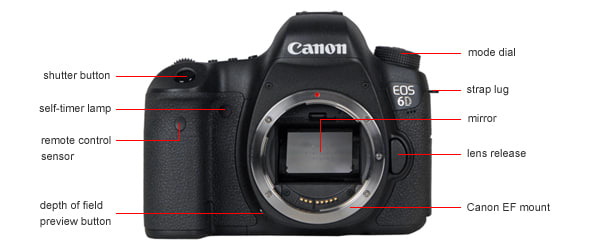
Back
{{section_header}}{{section.name}}{{/section_header}}
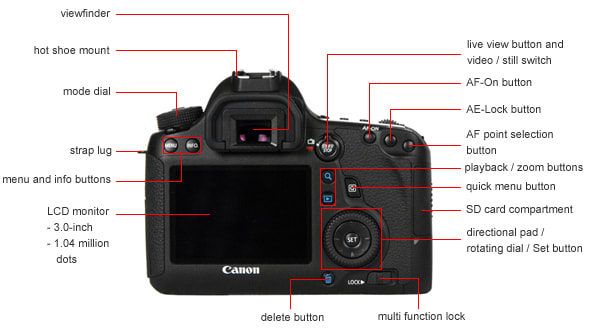
Sides
{{section_header}}{{section.name}}{{/section_header}}
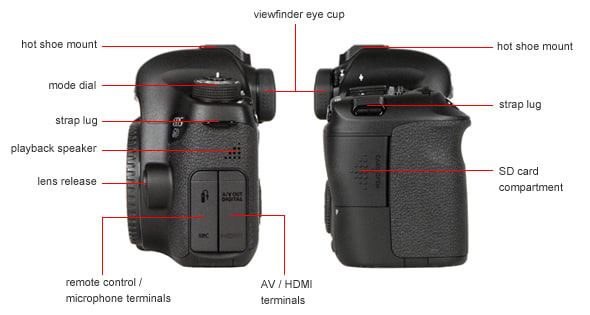
Top
{{section_header}}{{section.name}}{{/section_header}}
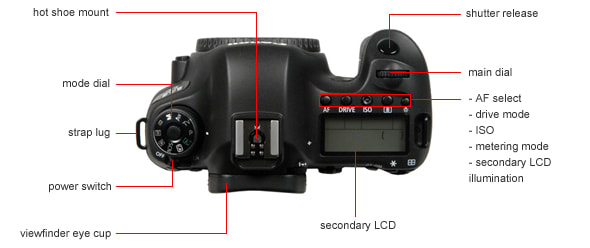
Bottom
{{section_header}}{{section.name}}{{/section_header}}

In the Box
{{section_header}}{{section.name}}{{/section_header}}
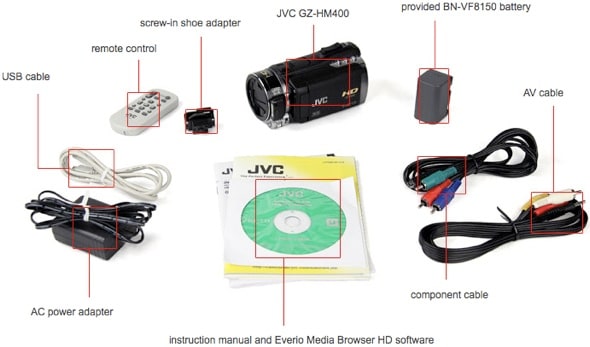
• Fujifilm X-Pro1 digital camera
• neck strap
• AC power cable
• Owner's Manual / Spanish Owner's Manual
• wall socket adapter
• NP-W126 rechargeable battery
• microUSB cable
• software CD-ROM
• registration / warranty information
Kit Lens & Mount
{{section_header}}{{section.name}}{{/section_header}}
The X-Pro1 has no included kit lens, though we suppose the 35mm f/1.4 is the most "standard" of the three. Fujifilm is also marketing a 60mm f/2.4 macro or portrait lens and a 18mm f/2.0 wide angle lens. We were lucky enough to shoot with all of them.
Each barrel is designed with manual rings for both focus and aperture. The focus rings aren't mechanically 1:1, leaving you at the mercy of a moderately precise electronic manual focus interface. The aperture rings, on the other hand, are very satisfying. Excellent tactile feedback means operating the aperture is fun and precise. The barrel is marked for full-stop intervals, though third-stops are possible too. After the narrowest setting, the "A" position returns aperture control to automatic. This automatic setting, plus a similar one on the shutter dial, eliminates the need for a mode dial: simply automate whichever variables you prefer.
All three lenses are very sturdy and, as you may have guessed, design is totally consistent with the body since they released at the same time. The color scheme is a perfect match and included metal lens hoods are a nice touch.
Fujifilm's new X-mount is making its debut with the X-Pro1, and so far only the three aforementioned "XF" lenses are available. There's talk of an upcoming adapter that will add compatibility with Leica M-mount lenses, but so far all we've seen are third-party products.
Of course the three lenses are already fairly versatile by themselves, minus a long zoom solution, but we'll have to wait and see what the future has in store for this mount.
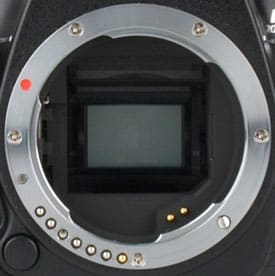
Classic Pentax lenses can be mounted with readily available adapters.
Sensor
{{section_header}}{{section.name}}{{/section_header}}
The camera's 16.3 megapixel APS-C CMOS sensor is apparently a brand new design, taking advantage of a new technique that Fujifilm is branding "X-Trans." Essentially they've made two major changes: the low-pass filter has been removed entirely, and the pixel array has been altered to a configuration that seems more randomized. The missing optical filter should improve resolution at the expense of moire, while the new pixel arrangement is designed to–theoretically–provide a more natural rendering.
All this of course sounds wonderful on paper, but we'll withhold final judgement for the Image Quality section.
Convergence areas of different sensor sizes compared
Viewfinder
{{section_header}}{{section.name}}{{/section_header}}
The X-Pro1's viewfinder is one of the best we've seen. This triple-function device may be set to either optical, electronic, or hybrid mode (like the HUD on a fighter jet). We spent most of our time using the hybrid method, since it's just so darn cool, but if that's not for you, a manual lever on the front panel cycles through the different options.
For fully electronic use, a tiny screen slides into view, and the image is projected on there. This EVF is far more responsive than most, and introduced only the tiniest bit of lag while framing. We also love the eye sensor located right alongside, which automatically swaps display between the finder and the LCD, without the need to press a toggle button. Our only complaint is color accuracy, rendition of the EVF is a little too cool. But in a camera that so thoroughly fuses old and new, this viewfinder is perhaps the best example of that design mindset.
Display(s)
{{section_header}}{{section.name}}{{/section_header}}
On the rear panel you'll find an excellent 3-inch LCD with a very high (1,230k-dot) resolution. Glare and reflectivity can be a problem but only in broad daylight, and even then the panel is still sufficiently bright enough to playback images. Viewing angle is also very wide, a must for fixed-position monitors, and the screen is covered by a durable scratch-resistant plastic coating.
Flash
{{section_header}}{{section.name}}{{/section_header}}
There's no internal flash emitter built into the X-Pro1, but a hot shoe mount is centrally located on the top panel, and can be used with Fujifilm's EF-X20, EF-42, or EF-20 flash bulbs, as well as other accessories. We didn't receive a flash for testing, but did score available options and features, which are extensive and include slow sync, rear-curtain sync, red-eye removal, and more.
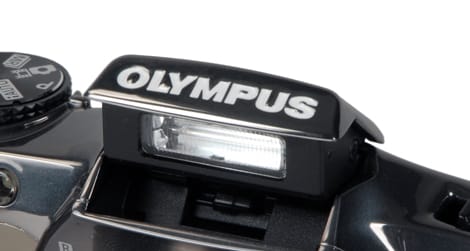
The flash emitter pops up from the top of the body via a mechanical release.
Connectivity
{{section_header}}{{section.name}}{{/section_header}}
Aside from the hot shoe, connectivity is rather simple. A plastic door on the right side of the chassis conceals a miniHDMI port for output to an HDTV, as well as a microUSB port for PC connectivity. The camera ships with a USB cable but you're on your own for HDMI. Battery charging via USB does not seem to be possible.
Photo Gallery
{{photo_gallery "Front Photo", "Back Photo", "Sides Photo", "Top Photo", "Bottom Photo", "Viewfinder Photo 1", "Viewfinder Photo 2", "Display Photo 1", "Display Photo 2", "Secondary Display Photo", "Flash Photo", "Lens Mount Photo", "Lens Photo 1", "Lens Photo 2", "Battery Photo", "Memory Photo", "Ports Photo 1", "Ports Photo 2", "Ports Photo 3", "Ports Photo 4", "Ports Photo 5", "Ports Photo 6", "Modes Photo", "Handling Photo 1", "Handling Photo 2", "Handling Photo 3", "Buttons Photo 1", "Buttons Photo 2", "Mic Photo", "Box Photo"}}
Image Quality
Aside from a hint of oversharpening, the X-Pro1 boasts some of the best image quality around. Between the extremely accurate new sensor and the precise, versatile selection of lenses, owners can expect to produce some amazing images in almost any shooting environment.
Sharpness
{{section_header}}{{section.name}}{{/section_header}}
We need to start by qualifying our results a little bit. At default settings we detected a bit of oversharpening produced by the X-Pro1's software, and this will boost scores beyond what the camera actually deserves. A professional DSLR, for example, wouldn't oversharpen at all, since that audience values raw image data over all else.
That being said, the Fujifilm X-Pro1 is the sharpest camera we've ever tested.
Oversharpening is confined to the central zones, with the effect quickly tapering off as we near the edge of the frame. As is typical, the most detail can be achieved at a medium aperture, with our best shots coming in at f/5.0. But really the entire aperture range produced high scores, with detail above 1800 MTF50s at wide or narrow settings, and an average of 2100 in the middle.
Since all the current XF lenses are primes, we couldn't test for multiple focal lengths, but we did test multiple lenses. The 35mm and the 18mm returned nearly identical results, and although we left the 60mm out, we have to assume it's just as excellent. These were extremely impressive and well-rounded results, leaving us with the impression that no matter what lens or f-number you need, the shot will be razor-sharp. More on how we test sharpness.
Image Stabilization
{{section_header}}{{section.name}}{{/section_header}}
The X-Pro1 is not equipped with image stabilization, but given the speed of these lenses that's almost irrelevant. For a similar model with a hardware stabilizer, consider the Sony NEX-7.
Color
{{section_header}}{{section.name}}{{/section_header}}
Another very impressive test for the X-Pro1. We recorded an error value of only 1.99 from this sensor, and since lower values are better in this metric, that places the camera far ahead of the 3.00 average. Looking over the gamut, we notice that errors, when they do appear, are restricted almost entirely to bright yellows and bright blues. It's possible this was intentional on Fuji's part, in order to reel in flesh tones and blue skies. All other shades are nearly dead on. Saturation is very slightly under, by about 3.5%, which is only barely noticeable. More on how we test color.
NOTE: Because of the way computer monitors reproduce colors, the images above do not exactly match the originals found on the chart or in the captured images. The chart should be used to judge the relative color shift, not the absolute captured colors.
Colors are so accurate in fact, that they surpass the mighty Canon 5D Mark III, as well as Sony's excellent NEX-7. Also note the drastic difference between the X-Pro1's color score and the aging Fuji X100, quite an improvement for only a year or so.
{{comparison_bars title="Color Score Comparison", attribute="Color Score", xLabel="Color Score"}}
Color Modes
{{section_header}}{{section.name}}{{/section_header}}
Fujifilm offers "Film Simulation" settings in place of color modes. They're the same thing, except they carry the brand names of the company's old film products. Like all new Fujifilm cameras, basic options like Provia (standard), Velvia (vivid), Astia (soft), are available, plus a few extras for monochrome and sepia. The X-Pro1 also contains two exclusive film simulations: Professional Negative High and Standard. Both are accurate but Professional Negative Standard is the most accurate of all, and we used this setting for all other tests.
White Balance
{{section_header}}{{section.name}}{{/section_header}}
White balance performance should be considered strictly average for this camera. As is often the case, the X-Pro1 struggled with incandescent tungsten light, but fared better under daylight and fluorescent, though not better than competitors did. While we imagine most buyers of this $1700 camera will do their color balancing in post-production, if that's not the case we recommend bringing along a white card.
Automatic White Balance ({{product.raw_scores['Auto White Balance Score']}})
In shots captured using the automatic white balance system, rendition was roughly 1900 degrees Kelvin too hot under tungsten light, however that figure drops to 267 K and 151 K under fluorescent and daylight respectively. All automatic white balance errors resulted in warmer color temperatures than ideal.
Custom White Balance ({{product.raw_scores['Custom White Balance Score']}})
Using custom white balance, things are a little bit better. Tungsten light errors average only 268 degrees Kelvin on the cool side, a totally acceptable and printable figure. Daylight and fluorescent are even better, clocking in at only 120 K and 138 K errors respectively. Oddly, most custom white balance errors make the scene extra cool, the opposite of automatic white balance.
White Balance Options
{{section_header}}{{section.name}}{{/section_header}}
White balance settings are available from the second page of the main menu or the upper right corner of the quick menu. Seven presets are available, including three separate fluorescent varieties and an underwater setting for use with an optional enclosure. You'll also find the custom option here, which uses is simple and legible interface. Direct entry is degrees Kelvin is also possible, and white balance shift is available with all modes.
Noise Reduction
{{section_header}}{{section.name}}{{/section_header}}
The X-Pro1's noise reduction software fails to distinguish the camera from close competitors. Though we suppose this isn't such a bad thing, after all the top of the line is becoming really good at eliminating noise. With noise reduction at its lowest setting, total image noise averages only 0.39% at ISO 100. In fact, you won't see noise levels cross 1.00% until ISO 3200. Very impressive. Artifacting rises smoothly but exponentially from there, eventually culminating in 2.60% noise at ISO 25600.
Each level of noise reduction behaves the same way, starting off slow, then becoming increasingly aggressive after ISO 3200. Cranking up this software all the way means pretty much any properly exposed shot can be used, even those captured at the lofty maximum ISO. More on how we test noise.
ISO Options
{{section_header}}{{section.name}}{{/section_header}}
ISO sensitivity is the only main shooting variable that isn't given a manual control dial. The sensor's range extends from 100 all the way up to 25600. From 200 to 6400, the user may choose third-stop intervals, such as 250 or 320. Four flavors of Auto ISO are available, which limit the maximum to either 400, 800, 1600, or 3200; but values about 3200 must–annoyingly–be set manually.
Dynamic Range
{{section_header}}{{section.name}}{{/section_header}}
The X-Pro1's large APS-C sensor is capable of excellent dynamic range. For best results, we recommend sticking with ISO 100, which achieved just over 7 full stops of usable image data. Performance falls off gradually and linearly from there, a mirror opposite of the gradual increase in noise reduction over the course of the ISO spectrum. We stay above 6 stops until after ISO 400, then 4 stops at ISO 3200 and 3 at 6400. Moving all the way above the sensor's native sensitivity, ISO 12800 and 25600 are each capable of roughly 2 stops of dynamic range.
Be aware that we test JPEG images, not RAW files, so those with the time or incentive for additional processing should be able to coax out some additional dynamic range. All test shots were captured without extra dynamic range enhancement, and we consider "usable" dark zones to be those with a signal to noise ratio of 10:1 or better. More on how we test dynamic range.
Believe it or not the X-Pro1 actually gives the Canon 5D Mark III a run for its money in this test, same goes for the Sony NEX-7 which shocked us with its dynamic range performance. While both of these cameras have wider maximum dynamic range, especially the Mark III, the real reason the X-Pro1 comes in third is because these models sustain their performance further up the ISO spectrum. The NEX-7, for example, still records nearly 6 stops at ISO 1600, while the X-Pro1 drops to 4.5 stops by then.
{{comparison_bars title="Dynamic Range Score Comparison", attribute="Dynamic Range Score", xLabel="Dynamic Range Score"}}
Chromatic Aberration
{{section_header}}{{section.name}}{{/section_header}}
Only the thinnest hair of chromatic aberration was visible in our lab shots, blue fringing on the left side on high contrast areas, yellow on the right. These are some of the best results we've ever recorded, and they put the excellent XF lenses into direct competition with kit lenses at the very top of the imaging market, including the Canon 5D Mark III. By the narrowest of margins, we detected slightly more chromatic aberration at narrower apertures, however the problem is so miniscule to begin with that this is all but impossible to notice.
Distortion
{{section_header}}{{section.name}}{{/section_header}}
It doesn't take an expert to notice the moderate to severe distortion at work while looking through the EVF or framing with the rear LCD, and as you may have guessed, this is especially true while using the 18mm wide-angle prime. But in all cases (at least for JPEG encoding) distortion is corrected in software before the final image is output. Since all distortion is gone before you see the final product, we're awarding the maximum score here.
Motion
{{section_header}}{{section.name}}{{/section_header}}
Videos are recorded in Full HD, though at only a 24p frame rate. As a result, motion isn't quite as smooth as the best mirrorless cameras, such as the Sony NEX-7. This deficiency won't be very noticeable to most viewers and is far from the worst quality of this camera's video. For that honor, we turn to sharpness.... More on how CamcorderInfo tests motion.
Video Sharpness
{{section_header}}{{section.name}}{{/section_header}}
Ouch! Although the X-Pro1 was able to resolve 650 lw/ph of detail horizontally and 600 vertically, that's only when the camera remains perfectly still. Even then, that's only half the story. Fujifilm's decision to remove the optical low-pass filter results in extremely distracting moire in all fine repeating patterns. We're talking bright, colorful moire that no one will miss. Very ugly. More on how CamcorderInfo tests video sharpness.
In our 60 lux test, moire wasn't quite so bad, however sharpness also takes a hit. The sensor could resolve only 400 lw/ph horizontally and 500 vertically this time around.
{{comparison_bars title="Video Sharpness Score Comparison", attribute="Video Sharpness Score", comps="video", xLabel="Video Sharpness Score"}}
Low Light Sensitivity
{{section_header}}{{section.name}}{{/section_header}}
Of course the tradeoff for an absent low-pass filter is more light coming through the lens. Because of that, and the wide open f/1.4 aperture found on the 35mm lens, we expected the X-Pro1 to fare quite well in our video sensitivity test. Fujifilm did not disappoint. In order to gather 50 IRE of image data, the sensor requires only 3 lux of ambient illumination. This incredibly impressive result is far better than what we expect from a high end DSLR, more like a high end camcorder instead.
Usability
We didn't love the camera's grip. Even with the attached hand grip accessory Fujifilm was nice enough to send along, the rear panel is just too crowded for comfort. With that said, everything else is nearly perfect for usability. Manual controls for every variable, simple menus that are barely necessary, and fast continuous shooting all make for an extremely fun shooting experience.
Automatic Features
{{section_header}}{{section.name}}{{/section_header}}
This is certainly not a camera for beginners, but the automation is there if you want it. Simply position the shutter and aperture dials onto the red "A" for automatic, and that variable will be automated. ISO can also be automated, though only up to 3200, and so can the rest of the usual suspects, such as white balance.
Buttons & Dials
{{section_header}}{{section.name}}{{/section_header}}
Manual control dials are some of the X-Pro1's defining features, and they are all a joy to use. The various aperture rings on all three XF lenses are the most fun, but we also get a large dial for shutter speed, a smaller one for exposure compensation, and an even smaller command dial on the rear panel, which is almost unnecessary given the detailed control afforded by the others. All of them feel great, even though we accidentally spun the EV dial once or twice. The shutter dial, on the other hand, has a smart locking button that allows free rotation of the dial except across the "A" setting in either direction, making it easy to switch back to automatic shutter by touch, without even looking at the dial.
The top plate is also home to the shutter release, which is precise and satisfying, and a customizable Function button, which can be set to active multiple exposure mode, preview depth of field, adjust ISO settings, change self-timer options, swap to video mode, and more.
Menu
{{section_header}}{{section.name}}{{/section_header}}
Fuji's menu interface isn't perfect, but it's far from the worst we've seen. The main menu is a simple tabbed list, divided between recording options and system preferences. If you don't know exactly what you're looking for, some aimless scrolling will be necessary, but such is the nature of a camera with so much detail available.
The quick menu uses a grid system, and is navigated via a combination of the directional pad and the rear command dial. It's a great shortcut for users familiar with Fuji's icons, but without any written descriptions here, beginners may need a few hours of experience to operate this menu effectively.
The retro style also introduces a few quirks. Video mode, for example, is hidden within the drive mode options. But by and large any moderately experienced photographer should be able to find their way around.
Instruction Manual
{{section_header}}{{section.name}}{{/section_header}}
Extensive printed instruction manuals in English and Spanish ship with the X-Pro1. They include tables of contents, clear diagrams, and all the information we needed for review. Electronic versions can be found on an included CD-ROM, and they are indexed for easy keyword searching.
Handling
{{section_header}}{{section.name}}{{/section_header}}
While we love the physical appearance of the camera, handling the body presents a few problems. The attractive dimpled surface surrounding the exterior does little to actually improve grip. Fujifilm has included a raised, rubberized area on the right hand side of the front panel, however this embellishment is too shallow to effectively aid handling by adult fingers.
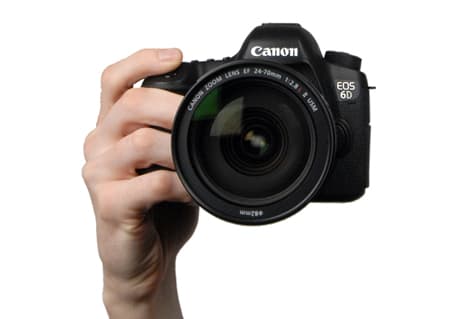
Things are even worse on the rear panel. Although there is sufficient empty space to rest the right thumb (barely), not one but two important buttons have been placed directly onto the adjacent lip. Despite their slight outward angle, it's almost impossible to pick up the X-Pro1 without accidentally pressing one of these buttons. For AE-L / AF-L that's not a big deal, but if you accidentally turn on the quick menu and, say, change white balance or resolution settings, that could ruin the day.
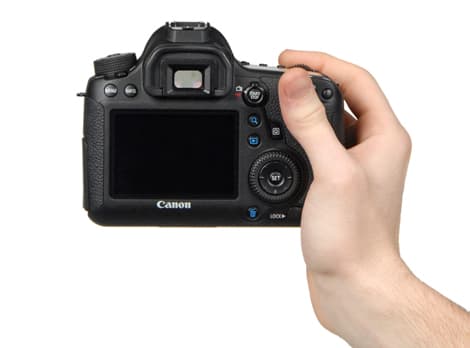
Fujifilm was kind enough to send along their optional hand grip accessory, which screws into the bottom of the camera and extends the front grip way out. This accessory is worth buying, since it eliminates grip problems on the front of the camera, however the rear thumb rest issues persist.
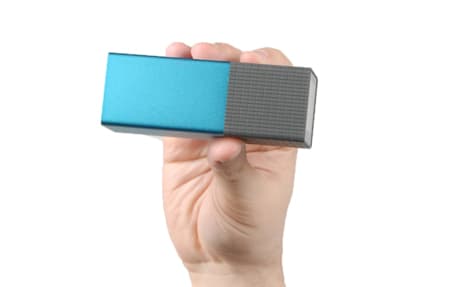
Buttons & Dials
{{section_header}}{{section.name}}{{/section_header}}
Manual control dials are some of the X-Pro1's defining features, and they are all a joy to use. The various aperture rings on all three XF lenses are the most fun, but we also get a large dial for shutter speed, a smaller one for exposure compensation, and an even smaller command dial on the rear panel, which is almost unnecessary given the detailed control afforded by the others. All of them feel great, even though we accidentally spun the EV dial once or twice. The shutter dial, on the other hand, has a smart locking button that allows free rotation of the dial except across the "A" setting in either direction, making it easy to switch back to automatic shutter by touch, without even looking at the dial.
The top plate is also home to the shutter release, which is precise and satisfying, and a customizable Function button, which can be set to active multiple exposure mode, preview depth of field, adjust ISO settings, change self-timer options, swap to video mode, and more.
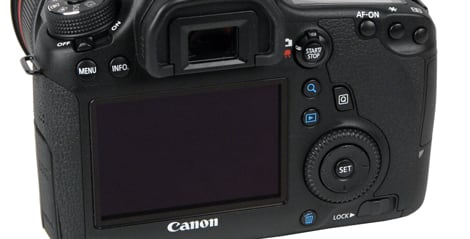
On the rear panel, the button layout is divided by the large LCD monitor. On the right, you'll find a directional pad for navigating the menus, surrounding the menu button itself. There's also the playback mode button, display button, and shortcuts on the thumb rest for AE / AF lock and access to the quick menu. Macro focus options are also found here.
Above the LCD, a view mode button toggles between full-time viewfinder framing, LCD framing, or–our favorite–the eye sensor, which swaps back and forth automatically. The viewfinder can be further controlled by a mechanical lever on the front of the body, within reach of the right pointer finger, which swaps between optical and electronic functionality.
Off on the left side of the LCD, three large buttons are well placed for easy access to drive mode mode, autoexposure, and autofocus options.
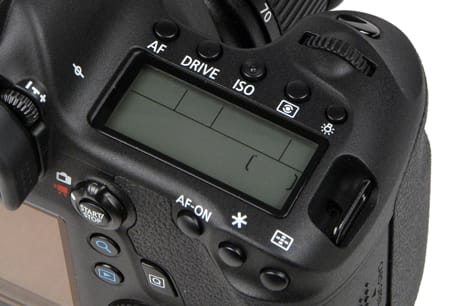
Display(s)
{{section_header}}{{section.name}}{{/section_header}}
On the rear panel you'll find an excellent 3-inch LCD with a very high (1,230k-dot) resolution. Glare and reflectivity can be a problem but only in broad daylight, and even then the panel is still sufficiently bright enough to playback images. Viewing angle is also very wide, a must for fixed-position monitors, and the screen is covered by a durable scratch-resistant plastic coating.
Viewfinder
{{section_header}}{{section.name}}{{/section_header}}
The X-Pro1's viewfinder is one of the best we've seen. This triple-function device may be set to either optical, electronic, or hybrid mode (like the HUD on a fighter jet). We spent most of our time using the hybrid method, since it's just so darn cool, but if that's not for you, a manual lever on the front panel cycles through the different options.
For fully electronic use, a tiny screen slides into view, and the image is projected on there. This EVF is far more responsive than most, and introduced only the tiniest bit of lag while framing. We also love the eye sensor located right alongside, which automatically swaps display between the finder and the LCD, without the need to press a toggle button. Our only complaint is color accuracy, rendition of the EVF is a little too cool. But in a camera that so thoroughly fuses old and new, this viewfinder is perhaps the best example of that design mindset.
Image Stabilization
{{section_header}}{{section.name}}{{/section_header}}
The X-Pro1 is not equipped with image stabilization, but given the speed of these lenses that's almost irrelevant. For a similar model with a hardware stabilizer, consider the Sony NEX-7.
Shooting Modes
{{section_header}}{{section.name}}{{/section_header}}
There is no hardware mode dial to be found on the X-Pro1, simply specify or automate whichever shooting variables you prefer. For example, adjusting any aperture ring will change the camera's mode to aperture priority. With this setup, the very concept of individual shooting modes is almost irrelevant.
Manual Controls
{{section_header}}{{section.name}}{{/section_header}}
All three XF lenses support manual focus, although they aren't truly mechanically manual. Aside from that, almost every conceivable manual control is supported, including detailed options for noise reduction, sharpness, dynamic range, color saturation, and focus area.
Focus
{{section_header}}{{section.name}}{{/section_header}}
Although we experienced our fair share of focus errors during our time with the X-Pro1, AF speed is encroaching on Olympus' territory, which is to say it is very fast for a contrast-based system. This is especially true when using the 18mm lens, though things do slow down while shooting with the 60mm. The most difficult subjects, like energized animals, were still a challenge. All three lenses have fairly strict minimum focus distances, so you may need to back off a bit to get a lock. But once you've done so, expect the autofocus system to be consistently fast and reliable.
Only two autofocus modes are available, automatic multi-zone and a user-definable zone mode. A combination AE-Lock / AF-Lock button is conveniently located on the rear thumb rest above the quick menu button. Here it's possible to pre-lock focus, exposure, or both, according to a separate menu setting. If the user configurable zone mode is selected, a prominent AF button on the left side of the rear monitor can be used to set the focus area from a 49-point grid. We really liked this simple interface, and found it both intuitive and functional.
Each of the three XF lenses currently available are equipped with manual focus rings, however these aren't mechanical manual rings. Instead they trigger an electronic interface that's moderately responsive but still less usable than a an all-mechanical ring.
One final quirk is the so-called "Continuous" autofocus system, activated by a mechanical lever on the front side of the body. This feature doesn't behave quite like we expected. Yes the camera will continually update focus as subject distances change, but once you press the shutter halfway down, focus is locked from then on. We suppose that's the best that can be done without phase detection, and sure it speeds the process up a tiny bit, but overall this was a disappointing minor feature.
Recording Options
{{section_header}}{{section.name}}{{/section_header}}
Three aspect ratios are available: 3:2, 16:9, and 1:1; and each have three possible resolutions of varying size and therefore quality. RAW shooting is only possible in 3:2 at full resolution.
Speed and Timing
{{section_header}}{{section.name}}{{/section_header}}
The X-Pro1 is fairly zippy for a mirrorless camera. Once the unit is powered on (an instantaneous affair as long as your card is properly formatted), you'll find the shooting experience to be quick, including the responsive menu system and short minimum interval between separate shots.
For even faster shooting, drive mode options include traditional continuous at "6fps" and "3fps" settings, as well as a range of brackets including autoexposure, ISO, film simulation, and dynamic range. Here you'll also find motion panorama and video modes.
Fujifilm's claim of 6 frame per second continuous shooting performance is sort of true, but not really. While shooting continuously, some shots are only 0.168 seconds apart, equivalent to 5.95 frames per second. However, shooting at least five continuous exposures results in an average of only 5.21 frames per second. That's still pretty fast of course, and thankfully RAW shooting is the exact same speed.
Self-timer options come in only two flavors: 2 second and 10 second countdown, and no automatic interval timer is included.
Focus Speed
{{section_header}}{{section.name}}{{/section_header}}
Although we experienced our fair share of focus errors during our time with the X-Pro1, AF speed is encroaching on Olympus' territory, which is to say it is very fast for a contrast-based system. This is especially true when using the 18mm lens, though things do slow down while shooting with the 60mm. The most difficult subjects, like energized animals, were still a challenge. All three lenses have fairly strict minimum focus distances, so you may need to back off a bit to get a lock. But once you've done so, expect the autofocus system to be consistently fast and reliable.
Only two autofocus modes are available, automatic multi-zone and a user-definable zone mode. A combination AE-Lock / AF-Lock button is conveniently located on the rear thumb rest above the quick menu button. Here it's possible to pre-lock focus, exposure, or both, according to a separate menu setting. If the user configurable zone mode is selected, a prominent AF button on the left side of the rear monitor can be used to set the focus area from a 49-point grid. We really liked this simple interface, and found it both intuitive and functional.
Each of the three XF lenses currently available are equipped with manual focus rings, however these aren't mechanical manual rings. Instead they trigger an electronic interface that's moderately responsive but still less usable than a an all-mechanical ring.
One final quirk is the so-called "Continuous" autofocus system, activated by a mechanical lever on the front side of the body. This feature doesn't behave quite like we expected. Yes the camera will continually update focus as subject distances change, but once you press the shutter halfway down, focus is locked from then on. We suppose that's the best that can be done without phase detection, and sure it speeds the process up a tiny bit, but overall this was a disappointing minor feature.
Features
We found little in the way of ancillary features, scene modes and digital effects are absent for example, but just about every necessity for traditional photography is available. One exception is video, which offers limited control versus other modes.
Recording Options
{{section_header}}{{section.name}}{{/section_header}}
All videos are recorded in H.264 at 24 frames per second, in either 1080p or 720p. Maximum length for a single clip is 29 minutes.
Video Controls
{{section_header}}{{section.name}}{{/section_header}}
While it's possible to choose resolution, film simulation setting, or white balance temperature, other than that we get no advanced controls for video. Recording movies with the X-Pro1 is essentially an automated experience.
Focus
No matter whether or not your focus lever is set to single or continuous, video mode always uses the continuous method. This can be extremely distracting given the potentially narrow focus of XF lenses like the f/1.4 35mm. The only way around this is to use manual focus, which is one of the only values that can be changed while a recording is in progress. Before recording, it's also possible to activate a digital zoom focus check, or perform a one-time autofocus lock using the AF-L button.
Exposure Controls
Aperture may be controlled manually using a given lens' control ring, however this must be done before a recording begins, otherwise the value will be locked in. The same is true for exposure compensation, which must also be configured beforehand.
Audio Features
{{section_header}}{{section.name}}{{/section_header}}
Two built-in microphones flank the autofocus assist lamp and provide stereo sound. No audio options are available, not even the popular "wind cut" technique.
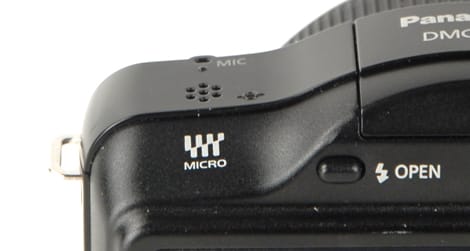
Conclusion
They don't make 'em like they used to, and Fujifilm has fully adopted this message, extending the philosophy not only to the design style of their first mirrorless camera, but to the quality of its construction as well. The X-Pro1 is the finest Fujifilm model currently available, and a surprise contender for first place in many of our image quality lab tests.
Of course it's no longer true to call the X-Pro1's retro inspiration "groundbreaking." After all, Fuji has already found success with their X100 and X10 cameras, not to mention similar efforts by the Olympus PEN series and now their new E-M5. However the X-Pro1 is certainly the best of this new generation of old-school cameras, thanks largely to the performance of three new "X-mount" lenses: one for macro or portrait photography, one for wide angle landscapes, and one for a bit of both. We were consistently amazed by the razor-sharp detail produced by each lens, all of which are primes (meaning fixed-zoom) and therefore less vulnerable to ugly distortion effects such as chromatic aberration.
Color rendition was also remarkable. When using the most accurate color mode (or "Film Simulation" mode, for Fuji cameras), test scores surpassed even juggernauts like the Canon 5D Mark III, meaning human subjects will look especially realistic. Rates of unwanted image noise were also relatively low, and better than close competition like the Sony NEX-7 or Olympus E-M5, even at the sky-high maximum sensitivity level. This, combined with the lens family's wide-open apertures, as well as some very strong dynamic range, makes the X-Pro1 an ideal camera for low light photography.
But if there's one feature that symbolizes the X-Pro1's fusion of classic and cutting-edge, that's got to be the new hybrid-viewfinder. While it's possible to frame your shots using the no-frills optical mode, an alternate and much cooler method is the heads-up display that overlays relevant data, sort of like a fighter jet cockpit. Even though the camera's rear LCD monitor is of very high quality, you'll find the viewfinder is simply too impressive to ignore. The third and final mode is fully electronic, for the most accurate framing, and all three options are toggled by a mechanical lever.
In fact just about everything on this camera is controlled by a mechanical lever, or manual dial, or rotating ring. That's what makes the X-Pro1 so much fun. While the phenomenal images are certainly rewarding in their own right, actually getting out there to shoot with this camera is as empowering as it is convenient. There's something about clicking a manual aperture ring into place that a software menu just can't replicate, and so much control at your fingertips makes for a more painless experience too. Beginners may be overwhelmed, but photography purists will fall in love with the design.
No camera is perfect, obviously, and neither is this one. We had some trouble handling the body because the rear panel is so crowded with buttons. The decision to place both the AE/AF-L button and the quick menu button directly onto the thumb rest was a bad one in our opinion. Video recording is the most significant drawback of all. Fujifilm's new "X-Trans" sensor design is clearly outstanding for resolving detail, but the tradeoff is distracting, artifacted video footage. This camera is purely for stills.
Ultimately the Fujifilm X-Pro1 is an exemplary marriage of form and function, at once taking advantage of both proven, traditional manual control, as well as modern technological advantages. Although the asking price is steep at $1700 for just the body, that money goes to quality, not novelty; and the lenses are sharp enough to easily justify their $600-650 cost. We enthusiastically recommend the X-Pro1 for anyone longing for some hands-on photography or, for that matter, anyone interested in sharp, gorgeous pictures.
Meet the tester
Chris was born and raised less than ten miles from our editorial office, and even graduated from nearby Merrimack College. He came to Reviewed after covering the telecom industry, and has been moonlighting as a Boston area dining critic since 2008.
Checking our work.
Our team is here to help you buy the best stuff and love what you own. Our writers, editors, and experts obsess over the products we cover to make sure you're confident and satisfied. Have a different opinion about something we recommend? Email us and we'll compare notes.
Shoot us an email
